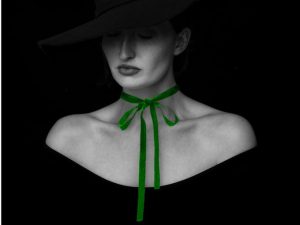
The “Husband Stitch” begins as a cautionary tale, evolves into an urban myth, and ends as a horror story. First, however, the writing style chosen by the author is interesting. Carmen Maria Machado begins the story with what is reminiscent of stage directions. She continues this throughout the story. Furthermore, in keeping with the story’s theme, these parenthetical sections can also be read as someone telling a campfire story. One could say “The Husband Stitch” is a story within a story. These interruptions by the author share a relationship with the narrator’s own tangents about various urban myths, thereby contributing to overall arch that this story is one of many. As the narrator says,
When you think about it, stories have this way of running together like raindrops in a pond. Each is borne from the clouds separate, but once they have come together, there is no way to tell them apart. (16)
If the reader is to understand that this is a story, how then can the narrator be trusted?
The sense that “The Husband Stitch” could be a cautionary tale begins when the narrator contemplates what could move outside the car window when she stares into the nighttime after having sex with her future husband. This sense becomes a certainty when the narrator tells the first two urban myths within the space of one page. It evolves into an urban myth when the narrator tells the third and fourth myths two pages after one and two with the last myth meant to convey to the reader that “The Husband Stitch” is one as well. However, the story quickly moves from urban myth to horror story when the narrator is given an unwanted and non-consensual medical procedure known as “the husband stitch” soon after giving birth. During this procedure, the doctor stitches up the perineum because it has been torn by the pain of childbirth. This dubious procedure is solely for the benefit of the male partner in order to give him pleasure during sex. From the conversation the narrator overhears as she goes in and out of consciousness, the reader can infer that this procedure, essentially, returns this female area to a virgin state. This is when “The Husband Stitch” becomes a horror story.
The obvious undertone of this story is the rape culture environment. It starts at the beginning when the future husband reaches out to touch the ribbon without asking for the narrator’s consent. This is followed by seven more incidents when he attempts to untie the ribbon without permission, the last time proving fatal. Her obvious pleas to leave it alone go unheard. Evidently, while the husband is a good father, he believes that his wife should give him everything. Furthermore, after his wife has just birthed his son, he and the doctor joke about, essentially, assaulting his wife via “the husband stitch.” This is to highlight the horrendous idea that women’s bodies are for the pleasure of men. Rape culture is sustained when nothing changes from one generation to the next. The narrator’s young son sees his father attempt to forcibly remove his mother’s ribbon; he then proceeds to attempt it himself due to his father’s actions. The narrator’s son grows up and dates a beautiful girl and he declares to his parents that he wants to marry his high school sweetheart. Perhaps his future wife will tell the same story as her mother-in-law?
Margie,
I really enjoyed how you said that “The Husband Stitch” could be a story within a story. It is something that I had not thought about and how you question the narrator’s trust because I find myself to do that naturally as a reader. Those were some very good observations that I thought were interesting!